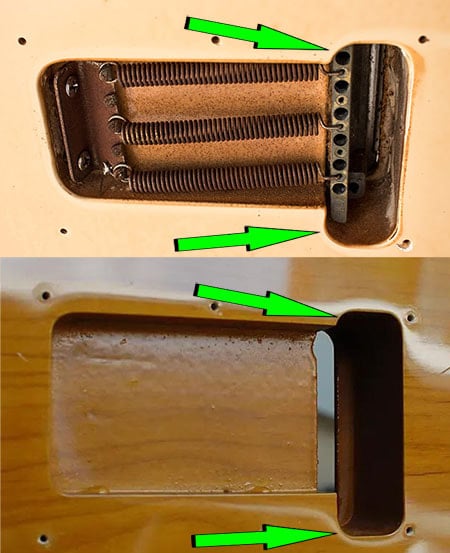|
There is a Stratocaster that has always sparked much discussion about its origin, but about which little or nothing is known: the Standard Stratocaster with Modern Logo, serial number beginning with “I”, “K” or “H” (or, rarely, “F” or “G”) and with the words “MADE IN USA” stamped into the wood. Many at first glance call it a fake, but it is a completely original guitar.
I do not want to clear any doubts about this guitar here which from now on, for convenience, I will simply call “I Series Stratocaster,” but to share some of my thoughts. |
|
First of all, I will quote what Fender says about these instruments, “A limited number of these H, I and K series guitars were made in '89 and '90. They were made for the export market and have Made in USA stamped on the heel of the neck. Serial numbers are on the front of the headstock.” However, this explanation does not clarify exactly what this guitar is.
It is clear that despite the “MADE IN USA” label, the Fender I Series Stratocaster appears to be more Japanese (or Eastern) than made in the United States. In fact, the tuning machines and electronics are typical of Japanese Stratocasters. The I, H and K serial numbers written on the headstock are precisely those also used on Japanese guitars built between 1988 and 1992, which coincides with the dates (1989 or 1990) found written in the neck pocket or on the neck heel of American I Series Stratocasters. In addition, the colour of the serial number is not black like on the Made in USA guitars, but light grey like the serial numbers found on the headstock of Japanese Standard Stratocasters of that period. |
The shape of the headstock does not match the shape of the Fenders made between 1989 and 1990 in the American Corona factory, recognizable by that particular profile responsible for their ‘pregnant headstock’ nickname. Instead, the vintage-correct shape of the headstock of the I Series Stratocaster was the same as the headstock of Japanese guitars.
The electronics were usually made in Japan, although I saw a few I Series Stratocasters with smaller potentiometers, reminiscent of those on Korean guitars. Oddly, some had skunk stripe necks, while others had none and rarely were the words MADE IN USA not stamped into the wood, but written on a sticker, or no reference was made to the country of manufacture.
Other considerations can be made as well.
At that time, a Stratocaster very similar to this one was available in Japan: the ST-40. Both the ST-40, and the I Series Stratocaster, had a 21-fret fingerboard, the same decals, the same bridge, and the same tuning machines, but the ST-40 didn’t have the MADE IN USA or MADE IN JAPAN markings. In addition, the serial number of the ST-40 usually began with F, G, I, H, or K. It looked exactly like the same guitar, as if the same instrument was also marketed in Japan under the name ST-40.
At that time, a Stratocaster very similar to this one was available in Japan: the ST-40. Both the ST-40, and the I Series Stratocaster, had a 21-fret fingerboard, the same decals, the same bridge, and the same tuning machines, but the ST-40 didn’t have the MADE IN USA or MADE IN JAPAN markings. In addition, the serial number of the ST-40 usually began with F, G, I, H, or K. It looked exactly like the same guitar, as if the same instrument was also marketed in Japan under the name ST-40.
|
The bridge was the same: six-screw type with thin-block and thin block saddles. The back plate on both guitars had the middle screw holes that line up horizontally and are not offset like other Fender Stratocasters (which usually suggests a fake). The tone and volume knobs sometimes had small dots under the numbers, both in the “made in USA” model and in the ST-40.
|
Removing the pickguard and backplate reveals other important details.
Some I Series Stratocasters “made in USA” had a body with SSS routing, others with HSH or HSS routing or swimming pool, but usually on all of them there was a small hole either under the pickguard or in the neck pocket. However, the strangest thing involved the neck pocket and the rear tremolo routing. Both the I Series Stratocaster and the Japanese ST-40 had a neck pocket with enlarged corners, sometimes called ‘Mickey Mouse Ears,’ typical of the American Standard Stratocasters of the 1980s and 1990s, but never present on the Japanese Stratocasters. In addition, the rear tremolo routing on both guitars, including the ST-40, had rounded corners like the American Standard, and not squared off like those on the Japanese guitars.
Some I Series Stratocasters “made in USA” had a body with SSS routing, others with HSH or HSS routing or swimming pool, but usually on all of them there was a small hole either under the pickguard or in the neck pocket. However, the strangest thing involved the neck pocket and the rear tremolo routing. Both the I Series Stratocaster and the Japanese ST-40 had a neck pocket with enlarged corners, sometimes called ‘Mickey Mouse Ears,’ typical of the American Standard Stratocasters of the 1980s and 1990s, but never present on the Japanese Stratocasters. In addition, the rear tremolo routing on both guitars, including the ST-40, had rounded corners like the American Standard, and not squared off like those on the Japanese guitars.
These peculiarities had initially led me to believe that the neck of both models was made in Japan because of the vintage-correct (not ‘pregnant’) headstock, and that the body was instead American even in the case of the ST-40. While it might have been plausible that the neck was of Japanese origin and was assembled with a body made in the U.S. and sold in the United States with the serial number I (or K and H), to think that the body of the ST-40 was made in the U.S. and shipped to Japan to be assembled with the Japanese neck does not make sense because it would have been too costly, especially considering that the ST-40 was a very cheap model.
The only possible explanation is that the body of the ST-40 was also Japanese. But how then do you explain the enlarged angles of the neck pocket? At that time, in order to maximize production, the Japanese Fujigen factory had subcontractors that produced some necks and bodies, especially when it came to cheap instruments that could be made by techniques other than Fujigen. This might be the case with the ST-40, whose body was probably not made in Fujigen, but was still made in Japan, so it might have some features that were different from the bodies of other Japanese Stratocasters.
The only possible explanation is that the body of the ST-40 was also Japanese. But how then do you explain the enlarged angles of the neck pocket? At that time, in order to maximize production, the Japanese Fujigen factory had subcontractors that produced some necks and bodies, especially when it came to cheap instruments that could be made by techniques other than Fujigen. This might be the case with the ST-40, whose body was probably not made in Fujigen, but was still made in Japan, so it might have some features that were different from the bodies of other Japanese Stratocasters.
Regarding the I Series Stratocaster, there are two possibilities.
The guitar could have both neck and body made in Japan, shipped to the U.S., and assembled with Japanese or otherwise cheap electronics. This would not be the first case of Japanese Fenders assembled in the U.S. and sold as Made in the USA.
Or, the body and neck could have been made in Mexico. To explain why this is not only possible, but likely, we need to review Fender's history. The Fender factory in Ensenada, which was set-up in 1987 by Fender engineer Bashar Darcazallie, initially was used for packing and making guitar strings. In 1989 the factory was moved to where it still stands today, on Calle Huerta, Ensenada where before manufacturing guitars it was involved in making some components for amplifiers.
A key role in the Ensenada factory was played by the Japanese Fugigen. It went into the joint-venture F&F with Fender USA to build the Mexican factory.
At this point it is important to remember what Bill Mendello, former Fender CEO, declared, “Fujigen brought their machinery with them, plus five or six people. We opened up our Mexican operation, and Fujigen trained the people, using their techniques. So, the manufacture of guitars in Mexico was more Japanese-like than it was US-like. We had a few people from the USA help them, but for the most part the training, the techniques, the painting, all were Japanese.”
The guitar could have both neck and body made in Japan, shipped to the U.S., and assembled with Japanese or otherwise cheap electronics. This would not be the first case of Japanese Fenders assembled in the U.S. and sold as Made in the USA.
Or, the body and neck could have been made in Mexico. To explain why this is not only possible, but likely, we need to review Fender's history. The Fender factory in Ensenada, which was set-up in 1987 by Fender engineer Bashar Darcazallie, initially was used for packing and making guitar strings. In 1989 the factory was moved to where it still stands today, on Calle Huerta, Ensenada where before manufacturing guitars it was involved in making some components for amplifiers.
A key role in the Ensenada factory was played by the Japanese Fugigen. It went into the joint-venture F&F with Fender USA to build the Mexican factory.
At this point it is important to remember what Bill Mendello, former Fender CEO, declared, “Fujigen brought their machinery with them, plus five or six people. We opened up our Mexican operation, and Fujigen trained the people, using their techniques. So, the manufacture of guitars in Mexico was more Japanese-like than it was US-like. We had a few people from the USA help them, but for the most part the training, the techniques, the painting, all were Japanese.”
|
The agreement was that FMIC would provide the building and the money while Fujigen would deal with construction techniques and machinery. At first, everything in Ensenada was managed by the Japanese, not by Fender USA. Above all, as Mendello said, the first Mexican guitars seemed more Japanese than American.
If we consider that the first Mexican Standard Strat appeared in the 1991 catalogue, it’s possible that between 1989 and 1990 the Ensenada factory was experimenting with the guitars and in order to not waste anything, these “pre-production” Stratocasters were sent to distributors regardless. Another sign that the I Series Stratocaster could have been Mexican are its ceramic pickups. Although some had a single magnetic bar like the Japanese pickups, the majority had two magnetic bars like the Mexican pickups. |




















